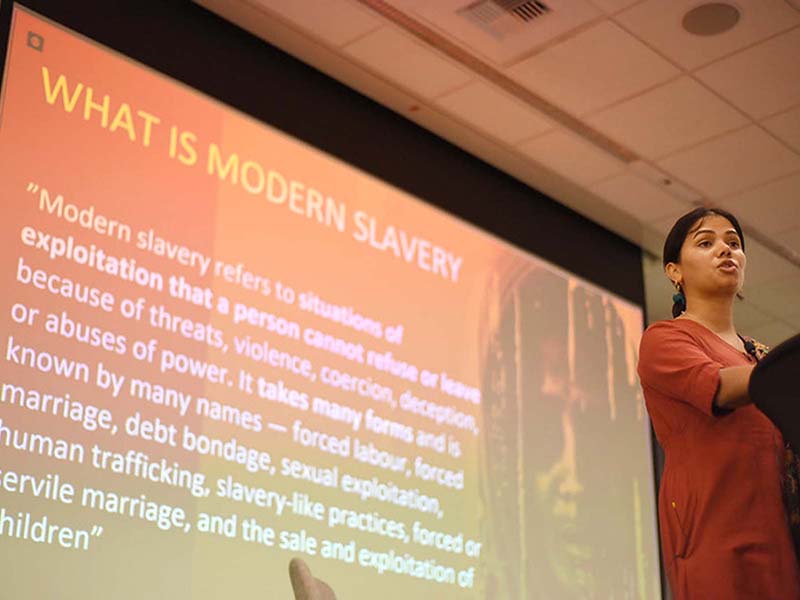This case study, published by BSR’s Center for Technology and Sustainability, examines the the net positive impact of ICT in online education, using as the case study Arizona State University’s current ASU Online education program for undergraduate degrees.
Summary
As online education has evolved in the American undergraduate education system, the use of information and communications technology (ICT) has skyrocketed. Online-class delivery systems are becoming the norm, even in face-to-face classes, as have online course-management and advising systems.
This report focuses on the net positive impact of ICT in online education, using as the case study Arizona State University’s current ASU Online education program for undergraduate degrees.
The ASU Online study indicates that there are both environmental and socioeconomic benefits to the use of ICT in online education.
Online education makes high-quality degrees accessible to a larger and more diverse group of people, many of whom would not otherwise earn a degree. Because these degrees are more accessible and affordable, they create positive socioeconomic impacts through increased incomes, greater productivity, and improved social conditions; we conservatively estimate the total socioeconomic impact to be US$545,000 per undergraduate degree. Positive environmental impacts result primarily from reduced student and faculty travel as well as avoided classroom construction, equaling an estimated carbon savings of 33.2 metric tons for that same undergraduate degree.
The ASU Online study suggests that ICT also enables innovation in education that can be scaled nationally and globally, satisfying the overwhelming need for access to education in developed, emerging, and developing countries.
Measuring the Environmental Benefits of ICT and Online Education
ASU Online was established to provide improved access to its educational offerings while also providing a new revenue stream for the university at a time when it faced reduced state and federal funding. However, the ASU Online campus has evolved to be a critical component of ASU’s sustainability plan: It plays a key role within ASU’s broader sustainability strategy, which includes climate neutrality, zero waste, zero wastewater, and low hazardous-material goals. The university continues to aggressively pursue these goals, including net zero energy by 2030, so ASU has made measuring environmental benefits a requirement across the university.
The Assessment Process
This report was prepared by ASU sustainability scientists from the university-wide Julie Ann Wrigley Global Institute of Sustainability, including the W.P. Carey School of Business, the Ira A. Fulton Schools of Engineering, and the Global Sustainability Solutions Services of the Walton Sustainability Solutions Initiatives, with both intellectual and financial support from Dell.
In order to assess the net positive impact of ICT at ASU Online, the research team developed high-level models of variables and populated them through structured interviews of key stakeholders and ICT platform experts across the education landscape, with a focus on Arizona State University and ASU Online. In addition, we conducted a literature review of published studies in areas relevant to net positive assessment of online education. We used delivery and completion of undergraduate degrees as the unit of analysis.
Because net positive is a relatively new concept, it was difficult to find any studies during our literature review that explicitly studied online education from this point of view. Instead, we focused our search terms on the various aspects of online education that create value or positive impacts to society.
The Net Benefits Model
Study Scope
For the purposes of this study, ASU means the entire ASU enterprise, consisting of 18 schools and colleges, five physical campuses, and the ASU Online virtual campus. ASU Immersive is used to describe the historic campus-based ASU, while ASU Online describes the unit that manages ASU degree programs through the ASU Online platform.
For the purposes of this case study, we view this greater ASU enterprise as a system that takes in enrollees, uses energy and other resources as inputs, and then produces outputs such as graduates and negative environmental impacts. Graduates, in turn, create positive socioeconomic impacts and outcomes. Increasing the number of graduates while reducing resource consumption enhances ASU’s overall net positive sustainability goal. ASU Online plays a critical role in achieving ASU’s overall sustainability goals.
Models and Metrics
Interviews and literature review provided the content for the development of two models and two key areas for output metrics: the holistic value proposition and the dynamic view of ASU Online through 2030.
Holistic Value Proposition
Any business model results in a specific set of benefits to stakeholders. This bundle of benefits—the value proposition—can be characterized for all stakeholders in the value network. This distribution of value capture is referred to as the Holistic Value Proposition (HVP) (O’Neill et al., 2006). The HVP for this study included 20 interviews of internal and external experts from the following stakeholder groups: broader society, online students, academic institutions offering online education, faculty, employers, and experts from the ICT industry.
A Dynamic View: ASU/ASU Online 2015-2025
Education innovation and its impact on the sustainability of higher education at ASU, which we measure in this section, is scalable both nationally and globally. In the ASU case, the net positive position of ICT in online education is primarily due to avoided carbon plus the positive socioeconomic impact of education access and affordability. Many more people will attain a degree through ASU than would have without online access.
Using a somewhat idealized best-case scenario of the ASU complex if it meets its growth and operational sustainability goals, the study determined that by 2025 ASU will be educating 100,000 students through immersive courses and 100,000 online, with nearly 75 percent of the total student body taking some portion of their classes online. This will have the net effect of producing more graduates for a much lower environmental footprint than today, and the use of ICT will be a key driver.
The big impacts at a national level are the economic and social returns of a degree, which we document in the next section of this report. The longer-term net positive story is one of innovation in a dynamic global market with its overwhelming need to educate students in developed, emerging, and developing countries. Online education may be the only hope for 9.5 billion people to get a high quality education in the coming decades.
Socioeconomic System-Wide Effects
Access to and completion of an online undergraduate degree program offers a number of social and economic benefits.
A key finding of this study, supported by the interviews, is that many ASU Online students would not get a degree at all if an online degree were not available. Access to education is one of the biggest contributions of ASU Online. Hout (2012) argues that the societal gain increases when more people are educated. If education boosts collective as well as personal productivity, then increased educational attainment for a population might be a key causal factor in overall economic growth—in fact, estimated social returns due to education might exceed individual returns. Lange and Topel (2006) observed this trend in metropolitan cities.
Ellwood & Jencks (2004) found that college graduates are less likely to go through divorces than those who have no degree. A number of studies have suggested that college education improves a person’s general health (Mirowski & Ross, 2003). Although causality is difficult to prove, a general argument made by many studies is that formal education improves a person’s understanding of the qualities and habits that promote good health.
Although there have been no attempts to establish causal linkages between education and happiness, Yang (2008) showed that people with a college degree are happier than those without a college degree.
The ASU Online Handprint and Footprint Model
In developing this report, the research team used the Global e-Sustainability Initiative (GeSI) methodological framework as a guide to develop the carbon-focused environmental aspects, or footprint, of the net positive statement. We also considered using the framework to express the socioeconomic benefits, or its handprint. The research team will provide the report data in GeSI, along with observations on its applicability to this type of net positive analysis, in the near future.
When it comes to assessing the net positive impact of ASU Online, key factors included in the scope of the model are the net ICT footprint of ASU Online and the potential social and economic handprint of students that online access enables to complete a degree.
The model quantifies handprint by including the expected additional average lifetime economic earnings after attaining a bachelor’s degree, adjusted for a shorter remaining career span, and potential higher net worth at retirement. Potential benefits are based on reported research findings regarding the lifetime value of completing an undergraduate degree compared to not completing the degree. We consider broader social returns largely in terms of avoiding and/or contributing social services. We conservatively estimate the net positive socioeconomic impact per degree to be US$545,000. The model also identifies the overall system-wide social impacts of attaining a college degree.
For the footprint, the model focuses on quantifying carbon dioxide equivalent (CO2e) emissions. Other environmental impact categories such as paper reduction, water use, and building construction were only briefly considered during this study and we made no attempt to formally quantify them. The factors we used to calculate the footprint in this study include increases in direct ICT emissions, net new data center construction and ICT equipment, telecommuting savings, and reduced construction and use of campus facilities. The net positive impact on emissions is conservatively calculated to be 28.3 metric tons of CO2e per degree produced.
The ratio of the positive benefits of producing a college graduate to the resources required to do so, including emissions, is growing larger quickly due to the maturation of online education and the dedication of higher-education institutions to making it so. ICT plays a central and critical role.
Limitations and Gaps, Future Research
During this research, we identified six significant limitations of the ASU Online study, and suggest next steps for future research.
The increased investment in ICT systems to accommodate online study and the increase in greenhouse gas (GHG) production from added ICT systems for online study are not thoroughly identified in this study. Next steps in a follow-up research project would include gathering and analyzing appropriate samples of use data.
The quantification of GHG savings from reduced campus infrastructure needs makes an assumption about the annual operating savings as a percentage of the reported GHG impact of the campus and a very high-level estimate of the net benefits from classroom construction avoidance. Steps in a follow-up research project would include validating the assumptions stated above for both operational and construction scenarios.
Initial findings on enabling the completion of a degree are based on a limited sample of cohorts that started the ASU Online undergraduate degree and interview information gleaned from ASU experts. A follow-up study might use a survey or structured interviews to gather more complete information about the demographics and perceptions of the student base in the ASU Online degree programs. Additional and larger cohorts could also be added.
Initial suggestions about lifetime income and lifetime social impacts are based solely on the many continuing studies of the impact of completing a college degree compared to only having some college courses completed. Although existing sources of data for these handprint economic and social factors may prove to be adequate, a follow-up study would explore these sources in greater depth.
This is a single case study. It will be hard to generalize to a broader base at a national level without conducting some additional case studies and/or gathering a limited set of data for a larger sample of universities. This should be done in a follow-up study.
Other environmental factors briefly discussed during this study and then excluded from it include water use on campus, solid waste disposal from campus to landfill, water runoff and sewage waste from campus, and food supply chain issues.
Conclusion
The contribution of ICT and ASU Online to the net positive position of the ASU complex is substantial and based almost entirely on increased access to and affordability of undergraduate degrees. At the same time, it is lowering the environmental footprint required to produce those degrees.
The important point is that ICT is enabling innovation in education in general and in online education specifically. The ratio of the positive benefits of producing a college graduate to the resources required to do so, including emissions, is growing larger quickly due to the maturation of online education and the dedication of higher-education institutions to making it so. ICT plays a central and critical role.
For complete data analysis and access to report appendices, download the report or view the ASU Online "how it works" page.
Let’s talk about how BSR can help you to transform your business and achieve your sustainability goals.








